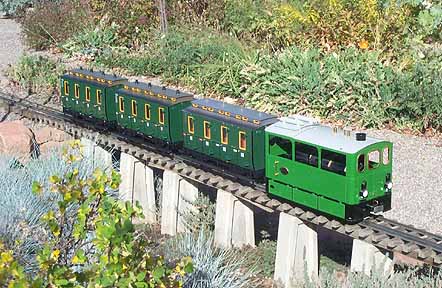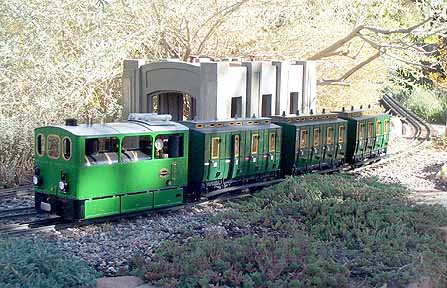
Back to Sidestreet Bannerworks
November 2003
Roundhouse tram locomotive
by Marc Horovitz

Tram engines were used in the latter part of the 19th century and early 20th century on street railways and for light industrial work. They appeared, in one form or another, all over the world. Typically, the moving parts were shrouded by side skirts to protect the delicate sensibilities of the horses, with whom they shared the roads. Trams were almost always small engines, designed for one-man operation. The operator had to both drive and fire, paying attention to the conductor or guard all the while.
The model
Roundhouse Engineering’s offering, called Stanley, is a freelance model of a typical European tram engine. The vivid green tram body covers a standard Roundhouse engine. Some prototype tram locomotives were set up in a fairly standard manner, while others were designed and built in all sorts of unusual ways.
This one has a single flue, gas-fired boiler. A gas tank stands in a rear corner and is accessed via a lift-up roof panel. The backhead is typical, with a throttle whose knob protrudes from a rear window for easy access with the roof down. There is also a pressure gauge, but no water glass. A level plug is included. A knurled thumb screw atop the boiler is removed for filling and a displacement lubricator stands next to the gas tank, below the pressure gauge.
The engine is powered by two of Roundhouse’s reliable, D-valve cylinders. Reversing is accomplished via a lever in the cab that actuates the modified Walschaerts gear found on most Roundhouse engines. The wheels are regaugeable by undoing set screws in the hubs. This engine, like (I believe) all Roundhouse engines, was offered either with manual or radio control. My version is manual, but it is equipped with servo brackets should I ever change my mind.
Stanley must not have been a popular engine, as it was withdrawn from production in 1998, just three or four years after its introduction. Tram engines in general, I’ve found, are considered odd and unusual. Many people have never heard of them. They are misunderstood.
The run
There is little to say about the run, really. The lighting-up ritual was assiduously adhered to and the track was wiped down while pressure came up. I tied on a train of LGB Prussian coaches, which I think look good with this engine. Stanley has center buffers with hooks, so a universal coupler (paper clip) had to be employed to hook up the train. When pressure had risen to about 30 psi, I put the engine into forward gear, opened the regulator, and stepped back. After a few hesitant coughs and chugs, with condensate pouring from the hole in the bottom of the smokebox, the train moved smartly off and I didn’t have to touch it until the gas ran out, quite a while later. It was a cool, crisp autumn day, and the steam effects were gratifying. Sometimes its just nice to run an engine that you know will give you no trouble whatsoever.
.
|
|
|
| Builder | Roundhouse Engineering (England) |
| Date built | 1995 |
| Gauge | Nº 0 (32mm) or Nº 1 (45mm) (regaugeable) |
| Scale | 16mm = 1' |
| Boilers | Single flue |
| Fittings | Throttle, safety valve, pressure gauge |
| Fuel | Butane |
| Blow-off pressure | 40 psi |
| Cylinders | Two, double-acting D-valve |
| Reversing gear | Modified Walschaerts |
| Lubricator | Displacement |
| Dimensions | Length, 10""; width, 4-5/8"; height, 6-5/8" |







Above: The cab is accessible by raising a roof panel. The gas tank is in the near corner, the regulator sticks out the back, and the reversing lever can just be seen on the left, above the builder’s plate.

Back to Sidestreet Bannerworks home page
This page and its contents
Copyright Sidestreet Bannerworks, 2003